Zhiliang Tian
Zero-resource Hallucination Detection for Text Generation via Graph-based Contextual Knowledge Triples Modeling
Sep 18, 2024



Abstract:LLMs obtain remarkable performance but suffer from hallucinations. Most research on detecting hallucination focuses on the questions with short and concrete correct answers that are easy to check the faithfulness. Hallucination detections for text generation with open-ended answers are more challenging. Some researchers use external knowledge to detect hallucinations in generated texts, but external resources for specific scenarios are hard to access. Recent studies on detecting hallucinations in long text without external resources conduct consistency comparison among multiple sampled outputs. To handle long texts, researchers split long texts into multiple facts and individually compare the consistency of each pairs of facts. However, these methods (1) hardly achieve alignment among multiple facts; (2) overlook dependencies between multiple contextual facts. In this paper, we propose a graph-based context-aware (GCA) hallucination detection for text generations, which aligns knowledge facts and considers the dependencies between contextual knowledge triples in consistency comparison. Particularly, to align multiple facts, we conduct a triple-oriented response segmentation to extract multiple knowledge triples. To model dependencies among contextual knowledge triple (facts), we construct contextual triple into a graph and enhance triples' interactions via message passing and aggregating via RGCN. To avoid the omission of knowledge triples in long text, we conduct a LLM-based reverse verification via reconstructing the knowledge triples. Experiments show that our model enhances hallucination detection and excels all baselines.
Perception of Knowledge Boundary for Large Language Models through Semi-open-ended Question Answering
May 23, 2024



Abstract:Large Language Models (LLMs) are widely used for knowledge-seeking yet suffer from hallucinations. The knowledge boundary (KB) of an LLM limits its factual understanding, beyond which it may begin to hallucinate. Investigating the perception of LLMs' KB is crucial for detecting hallucinations and LLMs' reliable generation. Current studies perceive LLMs' KB on questions with a concrete answer (close-ended questions) while paying limited attention to semi-open-ended questions (SoeQ) that correspond to many potential answers. Some researchers achieve it by judging whether the question is answerable or not. However, this paradigm is unsuitable for SoeQ, which are usually partially answerable, containing both answerable and ambiguous (unanswerable) answers. Ambiguous answers are essential for knowledge-seeking, but they may go beyond the KB of LLMs. In this paper, we perceive the LLMs' KB with SoeQ by discovering more ambiguous answers. First, we apply an LLM-based approach to construct SoeQ and obtain answers from a target LLM. Unfortunately, the output probabilities of mainstream black-box LLMs are inaccessible to sample for low-probability ambiguous answers. Therefore, we apply an open-sourced auxiliary model to explore ambiguous answers for the target LLM. We calculate the nearest semantic representation for existing answers to estimate their probabilities, with which we reduce the generation probability of high-probability answers to achieve a more effective generation. Finally, we compare the results from the RAG-based evaluation and LLM self-evaluation to categorize four types of ambiguous answers that are beyond the KB of the target LLM. Following our method, we construct a dataset to perceive the KB for GPT-4. We find that GPT-4 performs poorly on SoeQ and is often unaware of its KB. Besides, our auxiliary model, LLaMA-2-13B, is effective in discovering more ambiguous answers.
LTOS: Layout-controllable Text-Object Synthesis via Adaptive Cross-attention Fusions
Apr 21, 2024



Abstract:Controllable text-to-image generation synthesizes visual text and objects in images with certain conditions, which are frequently applied to emoji and poster generation. Visual text rendering and layout-to-image generation tasks have been popular in controllable text-to-image generation. However, each of these tasks typically focuses on single modality generation or rendering, leaving yet-to-be-bridged gaps between the approaches correspondingly designed for each of the tasks. In this paper, we combine text rendering and layout-to-image generation tasks into a single task: layout-controllable text-object synthesis (LTOS) task, aiming at synthesizing images with object and visual text based on predefined object layout and text contents. As compliant datasets are not readily available for our LTOS task, we construct a layout-aware text-object synthesis dataset, containing elaborate well-aligned labels of visual text and object information. Based on the dataset, we propose a layout-controllable text-object adaptive fusion (TOF) framework, which generates images with clear, legible visual text and plausible objects. We construct a visual-text rendering module to synthesize text and employ an object-layout control module to generate objects while integrating the two modules to harmoniously generate and integrate text content and objects in images. To better the image-text integration, we propose a self-adaptive cross-attention fusion module that helps the image generation to attend more to important text information. Within such a fusion module, we use a self-adaptive learnable factor to learn to flexibly control the influence of cross-attention outputs on image generation. Experimental results show that our method outperforms the state-of-the-art in LTOS, text rendering, and layout-to-image tasks, enabling harmonious visual text rendering and object generation.
360°REA: Towards A Reusable Experience Accumulation with 360° Assessment for Multi-Agent System
Apr 08, 2024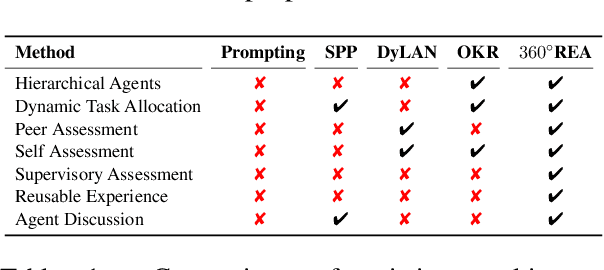
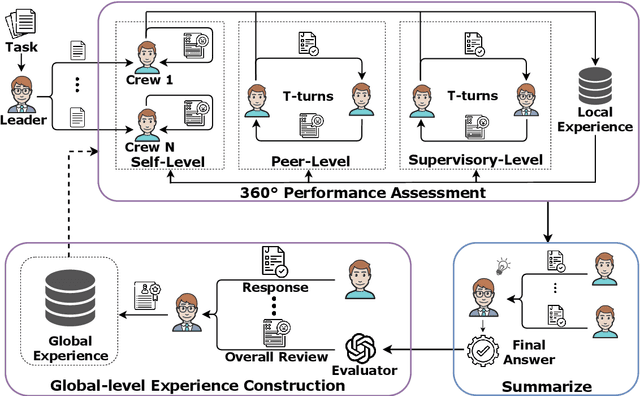
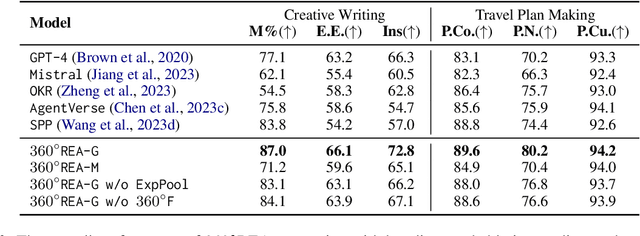
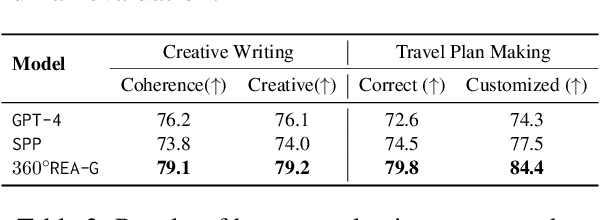
Abstract:Large language model agents have demonstrated remarkable advancements across various complex tasks. Recent works focus on optimizing the agent team or employing self-reflection to iteratively solve complex tasks. Since these agents are all based on the same LLM, only conducting self-evaluation or removing underperforming agents does not substantively enhance the capability of the agents. We argue that a comprehensive evaluation and accumulating experience from evaluation feedback is an effective approach to improving system performance. In this paper, we propose Reusable Experience Accumulation with 360{\deg} Assessment (360{\deg}REA), a hierarchical multi-agent framework inspired by corporate organizational practices. The framework employs a novel 360{\deg} performance assessment method for multi-perspective performance evaluation with fine-grained assessment. To enhance the capability of agents in addressing complex tasks, we introduce dual-level experience pool for agents to accumulate experience through fine-grained assessment. Extensive experiments on complex task datasets demonstrate the effectiveness of 360{\deg}REA.
Learn to Disguise: Avoid Refusal Responses in LLM's Defense via a Multi-agent Attacker-Disguiser Game
Apr 03, 2024Abstract:With the enhanced performance of large models on natural language processing tasks, potential moral and ethical issues of large models arise. There exist malicious attackers who induce large models to jailbreak and generate information containing illegal, privacy-invasive information through techniques such as prompt engineering. As a result, large models counter malicious attackers' attacks using techniques such as safety alignment. However, the strong defense mechanism of the large model through rejection replies is easily identified by attackers and used to strengthen attackers' capabilities. In this paper, we propose a multi-agent attacker-disguiser game approach to achieve a weak defense mechanism that allows the large model to both safely reply to the attacker and hide the defense intent. First, we construct a multi-agent framework to simulate attack and defense scenarios, playing different roles to be responsible for attack, disguise, safety evaluation, and disguise evaluation tasks. After that, we design attack and disguise game algorithms to optimize the game strategies of the attacker and the disguiser and use the curriculum learning process to strengthen the capabilities of the agents. The experiments verify that the method in this paper is more effective in strengthening the model's ability to disguise the defense intent compared with other methods. Moreover, our approach can adapt any black-box large model to assist the model in defense and does not suffer from model version iterations.
LLM-based Privacy Data Augmentation Guided by Knowledge Distillation with a Distribution Tutor for Medical Text Classification
Feb 26, 2024



Abstract:As sufficient data are not always publically accessible for model training, researchers exploit limited data with advanced learning algorithms or expand the dataset via data augmentation (DA). Conducting DA in private domain requires private protection approaches (i.e. anonymization and perturbation), but those methods cannot provide protection guarantees. Differential privacy (DP) learning methods theoretically bound the protection but are not skilled at generating pseudo text samples with large models. In this paper, we transfer DP-based pseudo sample generation task to DP-based generated samples discrimination task, where we propose a DP-based DA method with a LLM and a DP-based discriminator for text classification on private domains. We construct a knowledge distillation model as the DP-based discriminator: teacher models, accessing private data, teaches students how to select private samples with calibrated noise to achieve DP. To constrain the distribution of DA's generation, we propose a DP-based tutor that models the noised private distribution and controls samples' generation with a low privacy cost. We theoretically analyze our model's privacy protection and empirically verify our model.
TFDMNet: A Novel Network Structure Combines the Time Domain and Frequency Domain Features
Jan 29, 2024Abstract:Convolutional neural network (CNN) has achieved impressive success in computer vision during the past few decades. The image convolution operation helps CNNs to get good performance on image-related tasks. However, it also has high computation complexity and hard to be parallelized. This paper proposes a novel Element-wise Multiplication Layer (EML) to replace convolution layers, which can be trained in the frequency domain. Theoretical analyses show that EMLs lower the computation complexity and easier to be parallelized. Moreover, we introduce a Weight Fixation mechanism to alleviate the problem of over-fitting, and analyze the working behavior of Batch Normalization and Dropout in the frequency domain. To get the balance between the computation complexity and memory usage, we propose a new network structure, namely Time-Frequency Domain Mixture Network (TFDMNet), which combines the advantages of both convolution layers and EMLs. Experimental results imply that TFDMNet achieves good performance on MNIST, CIFAR-10 and ImageNet databases with less number of operations comparing with corresponding CNNs.
Resilient Practical Test-Time Adaptation: Soft Batch Normalization Alignment and Entropy-driven Memory Bank
Jan 26, 2024Abstract:Test-time domain adaptation effectively adjusts the source domain model to accommodate unseen domain shifts in a target domain during inference. However, the model performance can be significantly impaired by continuous distribution changes in the target domain and non-independent and identically distributed (non-i.i.d.) test samples often encountered in practical scenarios. While existing memory bank methodologies use memory to store samples and mitigate non-i.i.d. effects, they do not inherently prevent potential model degradation. To address this issue, we propose a resilient practical test-time adaptation (ResiTTA) method focused on parameter resilience and data quality. Specifically, we develop a resilient batch normalization with estimation on normalization statistics and soft alignments to mitigate overfitting and model degradation. We use an entropy-driven memory bank that accounts for timeliness, the persistence of over-confident samples, and sample uncertainty for high-quality data in adaptation. Our framework periodically adapts the source domain model using a teacher-student model through a self-training loss on the memory samples, incorporating soft alignment losses on batch normalization. We empirically validate ResiTTA across various benchmark datasets, demonstrating state-of-the-art performance.
POMP: Probability-driven Meta-graph Prompter for LLMs in Low-resource Unsupervised Neural Machine Translation
Jan 16, 2024Abstract:Low-resource languages (LRLs) face challenges in supervised neural machine translation due to limited parallel data, prompting research into unsupervised methods. Unsupervised neural machine translation (UNMT) methods, including back-translation, transfer learning, and pivot-based translation, offer practical solutions for LRL translation, but they are hindered by issues like synthetic data noise, language bias, and error propagation, which can potentially be mitigated by Large Language Models (LLMs). LLMs have advanced NMT with in-context learning (ICL) and supervised fine-tuning methods, but insufficient training data results in poor performance in LRLs. We argue that LLMs can mitigate the linguistic noise with auxiliary languages to improve translations in LRLs. In this paper, we propose Probability-driven Meta-graph Prompter (POMP), a novel approach employing a dynamic, sampling-based graph of multiple auxiliary languages to enhance LLMs' translation capabilities for LRLs. POMP involves constructing a directed acyclic meta-graph for each source language, from which we dynamically sample multiple paths to prompt LLMs to mitigate the linguistic noise and improve translations during training. We use the BLEURT metric to evaluate the translations and back-propagate rewards, estimated by scores, to update the probabilities of auxiliary languages in the paths. Our experiments show significant improvements in the translation quality of three LRLs, demonstrating the effectiveness of our approach.
Auto-Prox: Training-Free Vision Transformer Architecture Search via Automatic Proxy Discovery
Dec 14, 2023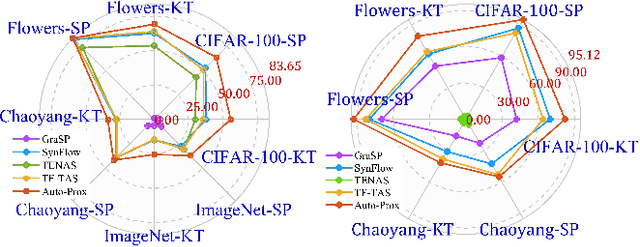
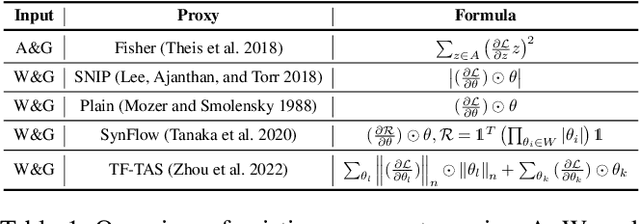
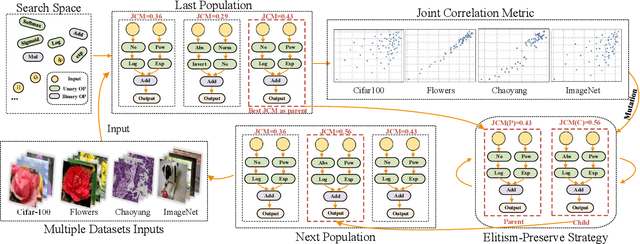

Abstract:The substantial success of Vision Transformer (ViT) in computer vision tasks is largely attributed to the architecture design. This underscores the necessity of efficient architecture search for designing better ViTs automatically. As training-based architecture search methods are computationally intensive, there is a growing interest in training-free methods that use zero-cost proxies to score ViTs. However, existing training-free approaches require expert knowledge to manually design specific zero-cost proxies. Moreover, these zero-cost proxies exhibit limitations to generalize across diverse domains. In this paper, we introduce Auto-Prox, an automatic proxy discovery framework, to address the problem. First, we build the ViT-Bench-101, which involves different ViT candidates and their actual performance on multiple datasets. Utilizing ViT-Bench-101, we can evaluate zero-cost proxies based on their score-accuracy correlation. Then, we represent zero-cost proxies with computation graphs and organize the zero-cost proxy search space with ViT statistics and primitive operations. To discover generic zero-cost proxies, we propose a joint correlation metric to evolve and mutate different zero-cost proxy candidates. We introduce an elitism-preserve strategy for search efficiency to achieve a better trade-off between exploitation and exploration. Based on the discovered zero-cost proxy, we conduct a ViT architecture search in a training-free manner. Extensive experiments demonstrate that our method generalizes well to different datasets and achieves state-of-the-art results both in ranking correlation and final accuracy. Codes can be found at https://github.com/lilujunai/Auto-Prox-AAAI24.
 Add to Chrome
Add to Chrome Add to Firefox
Add to Firefox Add to Edge
Add to Edge